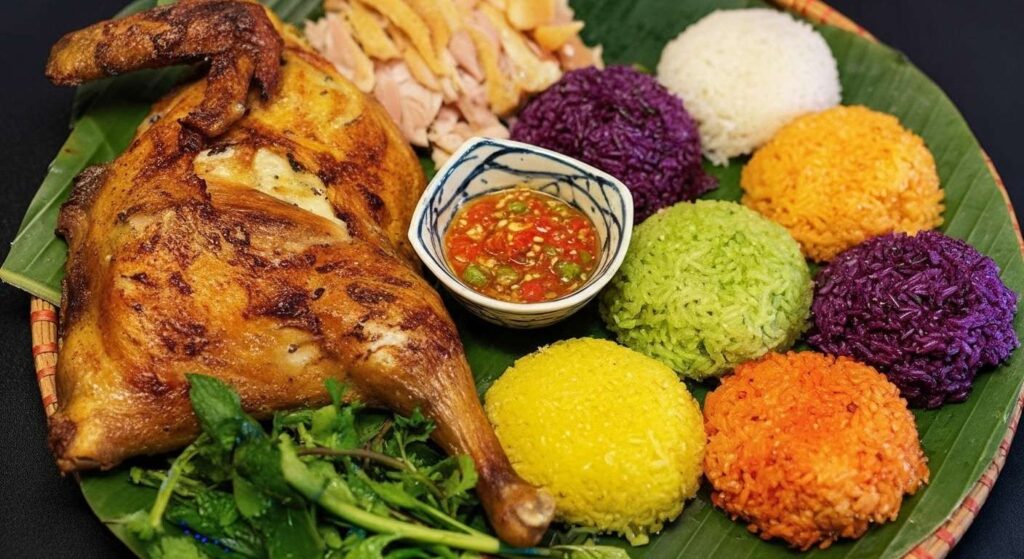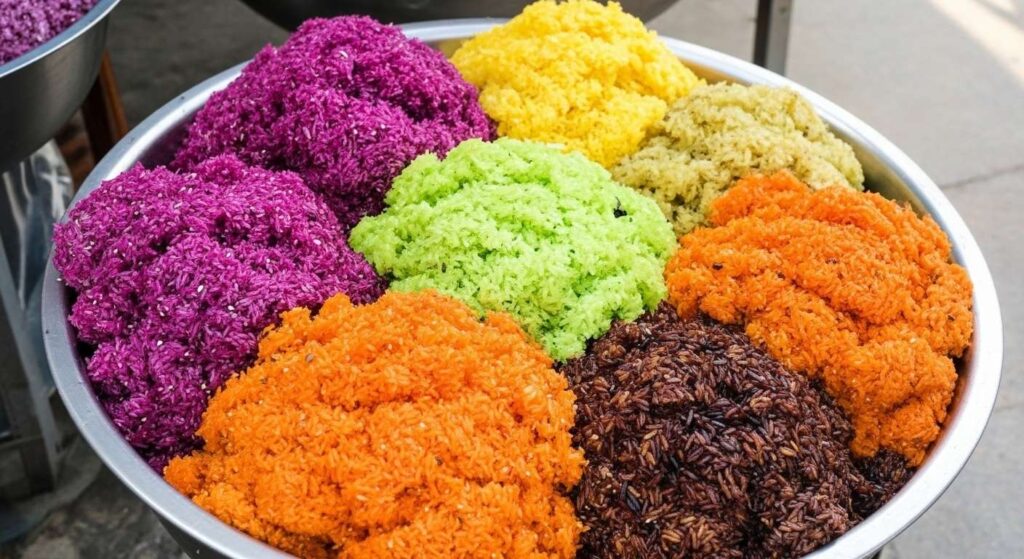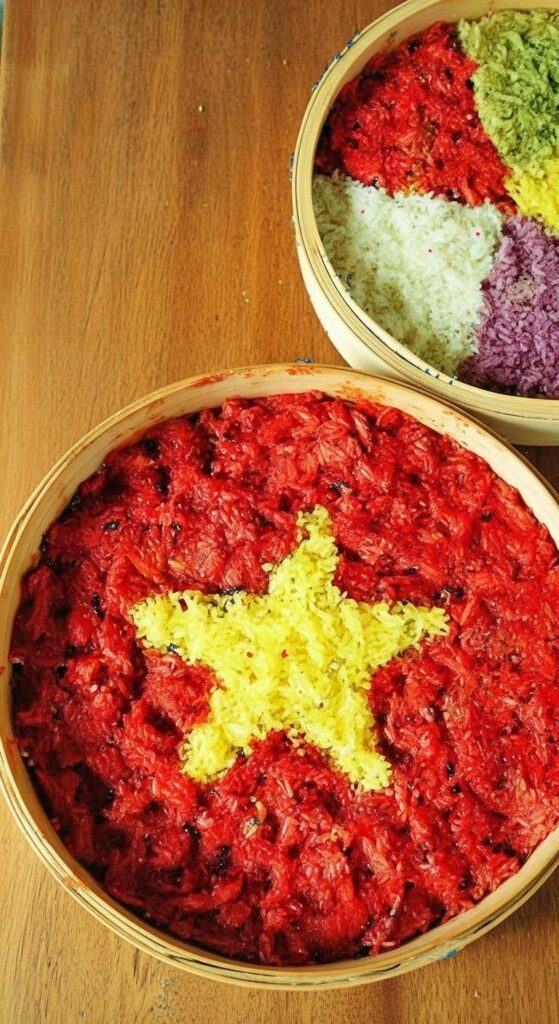Xôi Ngũ Sắc (pronounced “Soy Ng-oo Sac”) is one of Vietnam’s most visually stunning and culturally significant dishes. Translating literally to “Five-Color Sticky Rice,” this traditional dish is a vibrant blend of glutinous rice, naturally dyed to represent the five fundamental elements of the cosmos in Eastern philosophy: wood, fire, earth, metal, and water.
More than just a beautiful meal, Xôi Ngũ Sắc is deeply rooted in the traditions of the ethnic minority groups, particularly the Tày and Nùng people in the mountainous regions of Northern Vietnam. It is a celebratory dish, served during important festivals, weddings, and especially on Tết (Lunar New Year) as a symbol of prosperity, harmony, and gratitude to the heavens and earth.

Xôi Ngũ Sắc: The Basics
The Ingredients: The base is gạo nếp (glutinous or sticky rice), which is soaked for hours before being steamed. The colors are created using all-natural ingredients:
White (Metal): The natural color of the rice.
Green (Wood): Derived from soaking the rice in the juice of ginger leaves, bamboo leaves, or sometimes pandan leaves (though pandan is more common in the South).
Black/Dark Purple (Water): Extracted from the leaves of the cẩm (magenta plant) or certain forest herbs.
Yellow (Earth): Created by using turmeric powder or crushed ginger root.
Red/Magenta (Fire): Derived from the gấc fruit (a tropical fruit with intense red pulp) or the leaves of the cẩm plant.
The Symbolism: Each color holds profound meaning:
Yellow: Earth and prosperity.
Green: Forests, mountains, and the fertility of nature.
Red: Fire, passion, and good fortune.
White: Purity, metal, and ancestral respect.
Black/Purple: Water, and the stable foundation of the earth.
The Process: After being naturally dyed, each color of rice is typically steamed separately, often in a traditional wooden or bamboo steamer basket (chõ or xửng), until perfectly soft and sticky.
Varieties of Xôi Ngũ Sắc and Accompaniments
Xôi Ngũ Sắc itself is the foundational five-colored rice dish. Its “varieties” mostly come from the numerous savory or sweet toppings, classifying it under the broader category of Xôi (Sticky Rice):
| Topping Category | Accompaniment | Flavor Profile |
|---|---|---|
| Savory (Xôi Mặn) | Muối Vừng/Muối Lạc: Ground toasted sesame seeds and peanuts mixed with salt. | Earthy and Salty. The most traditional way to eat Xôi in the Northern mountains. |
| Savory (Xôi Mặn) | Chả Lụa, Giò: Vietnamese steamed pork sausage or thinly sliced lạp xưởng (Chinese sausage). | Rich and Savory. A popular breakfast choice for a complete meal. |
| Savory (Xôi Mặn) | Thịt Kho: Braised caramelized pork (often cubed). | Sweet-Savory and Rich. Turning the humble sticky rice into a hearty lunch or dinner. |
| Sweet (Xôi Ngọt) | Mung Bean Paste (Đậu Xanh): Sweetened, finely mashed steamed mung beans. | Creamy and Sweet. Often sprinkled on top, sometimes mixed with coconut milk. |
| Sweet (Xôi Ngọt) | Dừa Nạo: Freshly grated coconut and sugar. | Tropical and Aromatic. Enhances the natural sweetness and texture of the rice. |

How to Eat Xôi Ngũ Sắc
Communal Display: When served during celebrations, the five colors of rice are beautifully arranged together on a large platter or woven basket, often molded into decorative shapes like flowers or towers to maximize the visual impact.
Serving: Small portions of the sticky rice are taken by hand or with chopsticks from the large serving dish.
Pairing: Since Xôi Ngũ Sắc is often prepared slightly plain (not overly sweet or salted) to focus on the rice’s fragrance and color, it is almost always paired with a savory topping like Muối Vừng (sesame and peanut salt) or a piece of Chả Lụa. This provides the necessary saltiness to balance the sticky rice base.
Consumption: It is eaten at room temperature or warm, making it an excellent portable meal or festive offering.
Regional Differences
The presence and preparation of Xôi Ngũ Sắc are not uniform across Vietnam, primarily reflecting its origin and the general regional flavor profiles of xôi.
| Region | Key Characteristics of Xôi in the Region | Xôi Ngũ Sắc (Specific Differences) |
|---|---|---|
| Northern Vietnam | Heartland of Xôi and Xôi Ngũ Sắc. Focus is on subtle, pure flavors and the texture of the rice itself. | Most Authentic and Traditional. It is central to the culture of the Tày and Nùng ethnic groups. The colors are traditionally extracted from forest leaves, resulting in earthy and deeper hues. It is generally served savory with simple sesame salt (Muối Vừng) or pork sausage. |
| Central Vietnam | Less Prominent. Central cuisine is better known for spicy, complex dishes like Bún Bò Huế and savory, small bánh (cakes). | Rarely Found in Traditional Cuisine. When Xôi Ngũ Sắc is made, it often follows the Northern style but may be a bit more seasoned, reflecting the Central preference for bolder flavors. However, it does not hold the same deep cultural significance as it does in the North. |
| Southern Vietnam | Sweet and Tropical. Southern Xôi is often sweeter, richer, and uses more coconut milk. | A Modern, Dessert-Style Dish. Xôi Ngũ Sắc in the South is generally a newer adaptation, often served sweet. It is heavily infused with coconut milk for richness, and its colors (especially green) are more likely to be brightened by ingredients like pandan leaf for a stronger tropical aroma and flavor. It is often topped with sugar, grated coconut, and sweet mung bean paste. |




